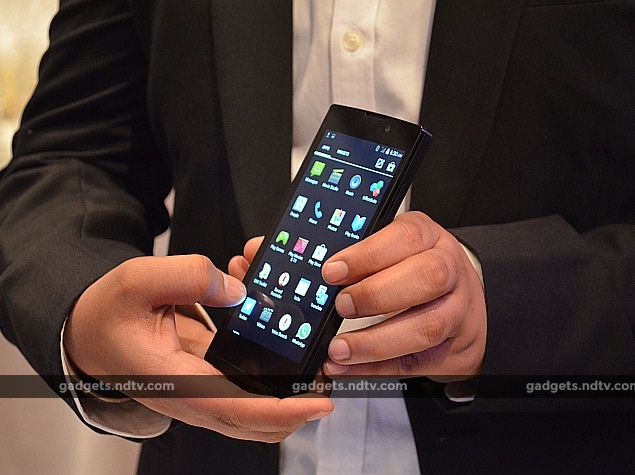- Home
- Mobiles
- Mobiles Reviews
- Lava Iris Fuel 60: First Impressions
Lava Iris Fuel 60: First Impressions

Lava, the Indian smartphone company known for its low-cost handsets, on Tuesday launched the Iris Fuel 60 in India. This is the second smartphone in its new 'Fuel' series after the Iris Fuel 50. Like the Iris Fuel 50, the Iris Fuel 60 too focusses on the handset's supposedly 'stupendous' battery, which as the company claims, offers up to 32 hours of talk time on 2G networks and a quick-charge time of 3 hours, 15 minutes.
Notably, the Lava Iris Fuel 50, which was launched in October at a price tag of Rs. 7,799, packs a 3,000mAh battery and can deliver up to 13 hours of talk time and up to 360 hours of standby time on 3G networks.
![]()
Now, with a 4,000mAh battery capacity, Lava Iris Fuel 60 priced at Rs. 8,888 has become the smartphone with the highest capacity battery in the sub-Rs. 10,000 segment. Its 4,000mAh battery is larger than those of popular smartphones in its category, such as the Xiaomi Redmi 1S (2,000mAh), Motorola Moto E (1,980mAh), and even the Asus ZenFone 5 A501CG (2,110mAh).
This phone feels sturdy at first. The dimensions of 144.8x72.8x10.2mm mean it is considerably thick, as seen in the images. This is the cost of the huge battery the handset possesses. The front, made of Corning Gorilla Glass 3, is a huge fingerprint magnet. The rear camera is placed in the top left corner with its flash, and the speaker grille is on the lower left.
![]()
The dual-SIM Lava Iris Fuel 60 runs Android 4.4 KitKat which is now slightly dated. However, company officials confirmed during the launch that an Android 5.0 Lollipop update is in the works and will arrive soon.
The smartphone is powered by the widely used MediaTek MT6582 quad-core processor which is clocked at 1.3GHz, along with 1GB of RAM. Interestingly, the lower-priced Iris Fuel 50 shares the same specifcations, meaning the main difference between the two is battery capacity, and both handsets' performance should be very similar.
In our short time with the device, which has a few of the company's own minor UI tweaks on top of Android, it seemed especially sluggish when scrolling through menu screens. On the other hand, the 5-inch HD (720x1280-pixel) screen was vibrant, and both text and images were crisp.
![]()
As for the camera, the Lava Iris Fuel 60 sports a decent 10-megapixel rear camera with an LED flash. The images taken in both day light and in low light (seen above) were satisfying enough. However, on switching to HDR mode, we were not able to take a single sharp image in low light as the shutter took 2-3 seconds to capture the scene at different brightness levels. Also, the camera sometimes tended to lose focus at times resulting in completely blurred images. The front-facing 2-megapixel camera worked fine and images came out slightly grainy, as expected.
![]()
Overall, the Iris Fuel 60 might prove to be a decent handset for those who care only about a long-lasting battery. As for specifications, the smartphone is average like any other handset in the same price segment. Do stay tuned for more detailed observations and comprehensive test results in our full review.
For the latest tech news and reviews, follow Gadgets 360 on X, Facebook, WhatsApp, Threads and Google News. For the latest videos on gadgets and tech, subscribe to our YouTube channel. If you want to know everything about top influencers, follow our in-house Who'sThat360 on Instagram and YouTube.
Related Stories
- Samsung Galaxy Unpacked 2025
- ChatGPT
- Redmi Note 14 Pro+
- iPhone 16
- Apple Vision Pro
- Oneplus 12
- OnePlus Nord CE 3 Lite 5G
- iPhone 13
- Xiaomi 14 Pro
- Oppo Find N3
- Tecno Spark Go (2023)
- Realme V30
- Best Phones Under 25000
- Samsung Galaxy S24 Series
- Cryptocurrency
- iQoo 12
- Samsung Galaxy S24 Ultra
- Giottus
- Samsung Galaxy Z Flip 5
- Apple 'Scary Fast'
- Housefull 5
- GoPro Hero 12 Black Review
- Invincible Season 2
- JioGlass
- HD Ready TV
- Laptop Under 50000
- Smartwatch Under 10000
- Latest Mobile Phones
- Compare Phones
- Infinix Smart 9 HD
- Lava Yuva Smart
- Samsung Galaxy S25 Ultra
- Samsung Galaxy S25+
- Samsung Galaxy S25
- Realme 14 Pro 5G
- Realme 14 Pro+ 5G
- Itel Zeno 10
- Asus Chromebook CR11
- Lenovo Yoga Slim 9i (2025)
- Asus ROG Flow Z13 (2025)
- Xiaomi Pad 7
- Titan Evolution
- Noise ColorFit Pro 6
- Sony 65 Inches Ultra HD (4K) LED Smart TV (KD-65X74L)
- TCL 55 Inches Ultra HD (4K) LED Smart TV (55C61B)
- Sony PlayStation 5 Pro
- Sony PlayStation 5 Slim Digital Edition
- Blue Star 1.5 Ton 3 Star Inverter Split AC (IC318DNUHC)
- Blue Star 1.5 Ton 3 Star Inverter Split AC (IA318VKU)
















